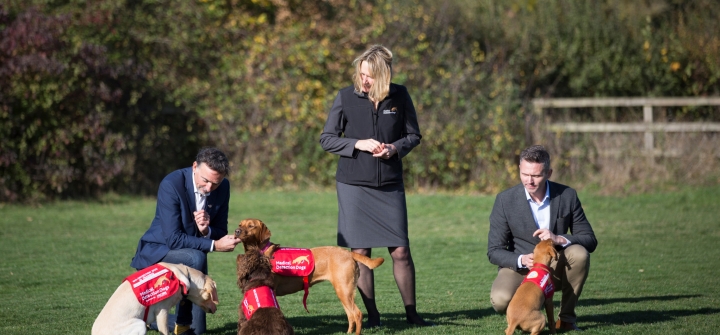Malaria Dogs
Steven Lindsay has found a new target for dogs’ legendary sense of smell: the malaria parasite.
Dogs successfully sniffed out Plasmodium in children who were infected but did not have a fever, according to research that the Durham University entomologist presented late last month at the American Society of Tropical Medicine and Hygiene. The dogs—a Labrador-Golden Retriever mix named Lexi and Labrador called Sally from Medical Detection Dogs—correctly diagnosed malaria 70% of the time among children from The Gambia, according to an ASTMH news release. The dogs from the UK-based charity smelled socks that they children had worn.
In this interview with Global Health NOW, Lindsay explains how the dog’s skills might be refined, how they might be used in malaria elimination scenarios and why this research could lead to new diagnostic approaches.
How can dogs smell malaria?
We are not sure, but people with malaria produce specific aldehydes from their skin, which are used by malaria mosquitoes to preferentially feed on malaria-infected individuals.
Why did you have the dogs smell socks worn by people in the study instead of just having them sniff people directly?
The socks were simply a tool to collect and store individual body odors. The socks were collected in The Gambia, frozen and then shipped to the UK for training and testing the dogs. The next stage is to train the dogs directly on people.
The dogs’ abilities to detect malaria are impressive—correctly identifying 70 percent of the infected children and 90 percent of the uninfected children. Is there any way to improve this?
Yes, we need to train them with more positive and negative samples. We also think it will be much easier for the dogs to detect malaria on real people, rather than socks.
It sounds like the dogs had trouble detecting different stages of malaria in individuals?
We had 4 out of 30 malaria-infected samples that had only sexual stage parasites, rather than the high-density asexual stages. The poor performance detecting sexual stages may be because they occur in very low densities or that they smell differently from asexual stages. Excluding the sexual stages, the sensitivity is even higher.
One possibility you’ve raised for dogs’ use in a real-world setting would be diagnosing people who are asymptomatic. But given the dogs’ relatively low accuracy, wouldn’t you still want to back up their diagnosis with more accurate lab confirmation?
Actually, they work as well as many malaria diagnostics. We see dogs being used at ports of entry to indicate a malaria carrier. Once indicated, the person would be offered a blood test to confirm whether the dog is correct or not. If malaria parasites were found, they would then be offered free treatment.
Tell us about the possibilities for using dogs in malaria elimination scenarios.
The dogs would operate at ports of entry in countries where malaria is eliminated or at very low levels, to reduce the chance of malaria-infected cases entering the country starting new outbreaks.
You’ve also posited that dogs could inform more high-tech malaria diagnostics. How might that work?
The Medical Detection Dogs [organization] is working with scientists to better understand how dogs recognize specific odor signatures, which they hope will inform the development of e-noses.
Ed. Note: This interviewed has been edited for clarity and length.
Join the tens of thousands of subscribers who rely on Global Health NOW summaries and exclusive articles for the latest public health news. Sign up for our free weekday enewsletter, and please share the link with friends and colleagues: http://www.globalhealthnow.org/subscribe.html
Principal investigator Steve Lindsay, Medical Detection Dogs CEO Claire Guest and London School of Hygiene and Tropical Medicine Professor James Logan share a moment with the remarkable sniffers. (Image: Durham University/Medical Detection Dogs/LSHTM)





